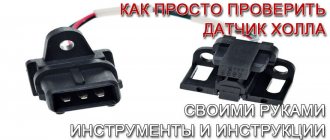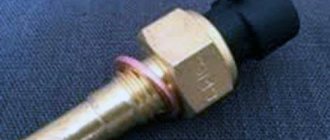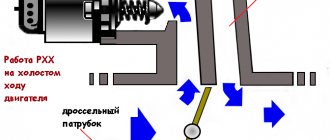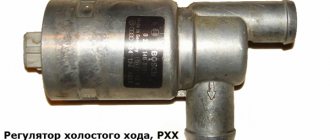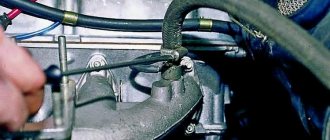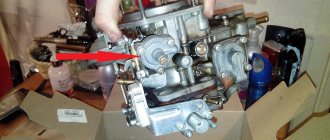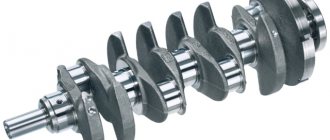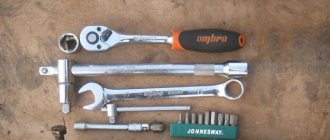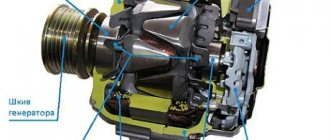Design, purpose and principle of operation of the sensor
IAC (idle air control) or IAC (idle air sensor) is a simple valve or actuator in design. Designed to control air flow when the throttle valve is locked. The control procedure is carried out in accordance with commands received from the microprocessor motor control module.
Russian car enthusiasts believe that the presence of an injector in a car allows it not to warm up the internal combustion engine, but this is not true. Do not overstress the power unit. When starting the internal combustion engine, it must run for a certain time without high speeds. The injector itself regulates idle speed, and the sensor is used to ensure stable speed when a load appears on the internal combustion engine. Both 8- and 16-valve engines use identical idle air controllers.
The device itself, presented in the form of a small-sized electrical unit, includes the following elements:
- spring element;
- electric stepper motor;
- a rod equipped with a needle at the end.
The presence of a working sensor makes it possible to correctly adjust the volume of fuel supplied to the combustion chambers. The volume of fuel can be less or more; we are talking about the supply of gasoline when driving at idle speed. The procedure for adjusting the fuel is carried out by pulling out or retracting the needle of the device, designed to shut off the gasoline supply channel.
Scheme of operation of the IAC on the “ten”
Where is the idle speed sensor located in a car?
The control device is mounted in the engine compartment. The sensor is installed next to the unit designed to control the dampers. The device is connected to this unit using special fixing screws.
Idling in a car with a carburetor
Adjustable idle speed (XX) VAZ 2110 carburetor includes such main parts as:
- channel for supplying gasoline from the float chamber;
- idle speed fuel jet;
- idle air jet;
- passageway;
- outlet channel for gasoline;
- idle speed sensor.
Gasoline enters through the main fuel line, then through the XX nozzle to supply fuel. The next stage is the diffusion of a mixture of gasoline and air masses. In this case, the air flow passes through a special line in the main jet.
Then the resulting mixture of air and fuel droplets is transmitted through the carburetor channels to the XX fuel supply adjusting screw, after which it is enriched with air masses from the bypass line. Then, through the outlet channel, the mixture enters the intake manifold of the fuel system.
How to identify sensor malfunctions?
There are two ways to determine a faulty DHC in the injection system - by symptoms that indicate a problem or by checking the device.
Symptoms of sensor failure
Signs that will help identify problems with the controller:
- The speed of the power unit began to float. We are talking about driving at idle speed or when the car is stuck in a traffic jam at a traffic light.
- Difficulties arose in starting the power unit. The engine starts poorly when cold or when warm. It is difficult to start the engine even when pressing the gas pedal.
- It is not possible to increase the speed by pressing the gas, even when the power unit is warm.
- The engine may stall for no reason if the driver turns the gearbox to neutral. Problems arise both while standing in a traffic jam, at a traffic light, and while driving at speed.
- A drop in speed is observed when energy consumers are activated. We are talking about the heating system, car radio, optical devices, and air conditioning system.
Ivan Vasilyevich spoke about the signs of problems in the operation of the IAC, its diagnosis and the features of replacing the device.
Popular ways to check the idle speed sensor
There are three options to diagnose the controller before repairing or replacing it:
- check the power supply of the device;
- perform diagnostics of its mechanical component;
- check the resistance parameter.
Checking for power supply to the sensor
To check the power supply to the idle speed sensor of the VAZ 2110, you will need a tester. It is advisable to use a multimeter; it will allow you to check both the voltage and the resistance value.
Algorithm of actions
Instructions for diagnosing the presence of power on the device:
- The car is put on the handbrake, its lever rises in the cabin.
- A search is performed for the regulator located in the engine compartment.
- The connector with wires connected to it is disconnected from the device. If necessary, remove the bolts securing the controller to the throttle body.
- A tester is taken. The negative terminal of the battery is connected to the car body, that is, to ground. The tester contacts must be connected to terminals A and D on the sensor. If a multimeter is used for testing, it must be switched to voltmeter mode in advance.
- The ignition diagnostics are performed and the tester readings are read.
- If a value corresponding to 12 volts appears on the display of a voltmeter or multimeter, then the problem lies in the battery being discharged. To restore normal operation of the internal combustion engine, the device must be recharged. The time it takes for the battery to charge depends on the discharge. If there is no data on the tester screen, a detailed check of the electrical circuit connecting the device or the microprocessor module of the internal combustion engine is performed. If the diagnostics showed 12 volts or more, then diagnostics of the resistance parameter is required.
Rinat Izmailov spoke in detail about the process of diagnosing the presence of power on the controller.
Checking the operation of the mechanical part of the sensor
When performing a test, it is advisable to diagnose the mechanical component of the device. The malfunction can be determined visually; this does not require a tester.
Algorithm of actions
Diagnostic Guide:
- The bolts that secure it to the power unit housing are unscrewed from the controller.
- The device is being removed from its seat.
- The connection point between the regulator and the plug is cleaned of traces of dirt and rust. For greater convenience, you can remove the fastenings of the throttle mechanism and move it to the side.
- The regulator is visually inspected for mechanical defects and traces of dirt. Bursting spring elements, as well as cracks on the device body indicate a sensor malfunction. The spring can be replaced so as not to change the device, but cracks usually cannot be “treated.” You need to make sure that there is no contamination on the needle rod and cone - there may be traces of soot and scale. The problem is solved by cleaning the device.
- Then the next device diagnostic option is performed. The regulator is removed and the connector with wires is connected. You need to press your finger on the needle and see how it behaves. When the ignition is turned off, the needle should push out a little. If there is no shock, you can try to solve the problem by cleaning the device.
- When performing mechanical diagnostics, it is necessary to measure the distance between the regulator body and the conical valve. Ideally it should be 2.4 cm.
Circuit resistance measurement
Diagnosis of the resistance parameter is carried out if the power test shows the presence of 12-volt voltage at the terminals. A tester is required for control.
Algorithm of actions
Test Guide:
- The tester probes are connected to the controller outputs in pairs. First you need to connect to pins A and B, and then to C and D.
- A certain value should appear on the tester screen. If the device is working, then the resistance parameter will be 50-80 Ohms.
- Then the diagnostics of contacts A and C, as well as B and D is performed. The test will show the resistance parameter tending to infinity. If the diagnostics showed different values, the device must be replaced. The presence of resistance at these contacts indicates a short circuit in the windings. The device cannot be repaired and must be replaced.
How to check the sensor?
If you have a tester, checking is easy:
- Set the VAZ 2110 to the handbrake;
- Disconnect the IAC connector to check;
- Check the voltage of the VAZ 2110, 2112 sensor circuit, while connecting the “minus” to the engine, the “plus” to the removed block, namely to terminals A: D (marked on the block, you can see the diagrams);
- The ignition is turned on and the readings given by the idle speed regulator are checked, which should be about 12 V. The value will be less - most likely the battery is discharged. When there is no voltage, it is necessary to check the entire circuit, and then the electronic control unit. There are no malfunctions, which means the circuit is working - the IAC installed on VAZ 2112 engines and other modifications are checked;
- The tester terminals are connected to the block, the circuit is as follows - first to terminals A: B, then to C: D. The resistance should be within 53 Ohms;
- Next, pairs A: C, B: D are checked - in this case, the resistance on a working product will be infinitely large.
When, as a result of these checks, the sensor reveals a discrepancy in the readings, it should be replaced. Also, the inoperative state of these VAZ 2110, 2112 engine sensors, in the unscrewed position, can be checked by attaching a block to them, then you need to turn on the ignition.
Thanks for subscribing!
When the power is connected to the working product, the rod with the needle will change position. No changes will occur on a broken sensor. If a breakdown of the idle air regulator is detected, of course, it must be repaired. But there is no need to rush to a car service center - you can do the repairs yourself, saving money and time. But first, in general, it is worth cleaning the IACs; often after this they return to “life”.
How to repair the idle speed sensor yourself?
The procedure for repairing the device consists of dismantling the regulator and cleaning it. To perform this task, you will need WD-40 or carburetor engine cleaner.
Sequence of actions when repairing the sensor
Algorithm of actions for repairs:
- The VAZ 2110 is placed on a flat surface to prevent arbitrary rolling. The parking brake lever is raised.
- The engine compartment of the car opens. The negative clamp is disconnected from the battery terminal, this will prevent a short circuit when performing the task.
- The regulator itself is located on the throttle body. You need to disconnect the plastic latch from it and disconnect the connector with the wiring.
- Use WD-40 or carburetor cleaner. With the help of liquid, all channels are cleaned; for this, the jet is directed directly into them. You can use a cotton swab treated with cleaner. For the best effect, it is recommended to wait some time after applying the product.
- Using a Phillips head screwdriver, unscrew the two bolts securing the regulator. The device is removed. Sometimes difficulties may arise during dismantling, since the bolt located next to the receiver may fall off when unscrewed. Therefore, it is recommended to first unscrew the left screw and then proceed to unscrew the right one. If there are no fasteners, which is typical for some VAZ 2110 models, the throttle device is completely dismantled.
- The cone needle and the regulator spring are cleaned from dirt and soot. The mounting hole of the device located on the throttle mechanism must also be cleaned. After cleaning, you need to dry the device and install it back.
- During further installation, it is recommended to clean the air duct on the throttle from contamination.
- The regulator is mounted in place. The engine is started and the operation of the controller is checked. If the problem remains after cleaning, the device must be replaced.
An example of cleaning a regulatory device is given by Alexander Filimonov.
How to replace the idle speed sensor on a VAZ-2110?
You can remove and replace the idle speed control device on a VAZ-2110 in a garage, if there are no problems in the sensor’s power supply circuit.
If there are faults in the power supply, it is not advisable to replace it, since this will not solve the problem of the regulator. For high-quality functioning of the DXH, damage in the wiring must be eliminated.
Tools, accessories and consumables for replacing the sensor
To complete the task you will need:
- screwdriver with Phillips blade;
- new regulator;
- a new seal, if not included with the DXX.
Sensor selection
When choosing a VAZ-2110 idle speed sensor for replacement, you need to take into account that devices of dubious origin have a shorter service life and more often fail than original devices.
Signs by which you can distinguish an original regulator from a fake one:
- Low-quality devices, like the originals, are equipped with a black body made of metal. But its length, compared to VAZ devices, is 1 mm less.
- Fake devices are equipped with three white rivets located on the body. But there are no caps on them, but they are present on the original production regulators. The diameter of each element is 3 mm, so it can be seen.
- Fake devices are equipped with white spring elements. Such springs are characterized by frequent winding. The original controllers have thinner coiling and the color of the spring is black.
- All regulators are equipped with rubber rings. Only on fake devices the rubber bands are thinner and black. On the originals, the shade of the part is more reddish and it is thicker.
- When buying a new controller, you need to pay attention to the tip of the product. On counterfeit devices it is darker than on original regulators.
- The packaging of the counterfeit part does not have any marks from the manufacturer. Visually, the packaging between the original and the fake also differs.
- Originals and fakes are equipped with a yellow sticker, which is located on the device body. On high-quality parts the sticker is equipped with a frame; on fake parts there is none.
Differences between original and fake IAC
Step-by-step replacement procedure
The replacement procedure is carried out in almost the same way as cleaning the device, but there are certain nuances:
- The battery is disconnected to prevent a short in the wiring.
- The plug with the electrical circuit is disconnected from the control device. If the car is equipped with an injection power unit, then to disconnect the connector you need to press on the plastic fastener.
- The bolts are unscrewed. As when cleaning, first unscrew the left fastener, and then the right one. The failed regulatory device is being dismantled.
- The surface on which the sealing element is mounted is also cleaned. The latter is checked for defects - abrasions, cracks, etc. If they are present, the sealing gum is replaced with a new one. Before installation, the seal is treated with engine fluid, after which it is mounted on the throttle seat.
- The controller is installed, a connector with wires for its power supply is connected. A wire is connected to the battery.
- After installation, a calibration procedure is performed. The microprocessor module must perform this independently; an electronic relay is used for this. To calibrate the new sensor, the ignition is turned on for a few minutes and then turned off. If the actions performed helped and the speed no longer floats, but remains at the same level, then the replacement procedure can be considered complete.
An example of replacing the idle speed control device on Lada cars of the tenth family with injection internal combustion engines is given by the channel In Sandro's garage.
Choosing a replacement regulator
On the VAZ-2110 with both 8-valve and 16-valve injection engines, a sensor with catalog number 2112-1148300 is used. Additionally, at the end of the marking there is a prefix consisting of two numbers, for example, 01, 02, 03, 04. This index indicates the manufacturer of the regulator (01 and 03 - “Pegasus”, 02 and 04 - KZTA). When choosing a replacement regulator, pay attention to two nuances - the seal and the height of the needle protrusion above the body. Factory spare parts use a red seal, while counterfeits use a black rubber element. The height of the needle protrusion above the body is 23 mm.
Before installing a new regulator, it is recommended to coat the sealing ring with a thin layer of engine oil to ensure a tight fit of the part in the seat and eliminate the possibility of air leaks.
Idle speed adjustment
It is possible that after replacing the regulator, the idle speed is unstable. This may be due to the fact that the idle speed is off and requires additional adjustment.
Before making adjustments, make sure of the following:
- The battery is fully charged;
- lubricating fluid and coolant are present in the engine in full; if necessary, they are added;
- All vacuum pipes and lines are connected to the power unit;
- complete tightness of the air flow suction system is ensured;
- the cylinders of the power unit have good compression, there are no problematic elements;
- the exhaust gas return system is functioning correctly;
- the throttle valve opens and locks without problems;
- the ventilating device of the engine cooling system is not started.
Algorithm of actions
Before performing the task, you must turn off all electrical equipment that consumes electricity (stove, optical instruments, glass heating system):
- The car's wheels must be set straight. The power unit starts and the parking brake lever rises. The engine warms up until the thermometer needle rises to the middle position. When adjusting the idle speed, the operating temperature of the internal combustion engine must be maintained; if pauses are made, additional heating is required. The power unit must operate at a speed of no more than 1 thousand per minute.
- If there is no tachometer (on carburetor internal combustion engines), the device is connected. The sensor manual is used for installation. When connecting, the internal combustion engine must be deactivated.
- The power unit starts again. In the engine compartment from the inspection window of the carburetor device, you need to make sure that the fuel level is located in the middle, on the line. Then the engine speed needs to be increased to 2-3 thousand per minute. It should work in this mode for several minutes. After this, let the engine idle for about a minute.
- The idle speed is read from the tachometer. The power unit needs to operate at approximately 750 rpm. A deviation of 50 rpm up or down is allowed. If the number of idle revolutions does not correspond, then the screw is rotated until the obtained data corresponds to the norm. If the idle speed adjustment does not occur, although all of the above systems are working, the carburetor may need to be repaired.
- If the car is not equipped with a catalyst device, then the procedure for adjusting the idle speed is similar. A screwdriver is used only to perform this task; it is installed in the notches of the adjusting bolt.
Video “The result of installing a low-quality IAC on a VAZ-2110”
Vyacheslav Kravchenko in the video showed the result of installing a defective idle speed control device on the “ten”.
Many people underestimate the importance of sensors or idle air control. But in fact, the speed stability depends on the correct operation of the IAC. It also prevents the car from stalling when the gearshift lever is in an intermediate position.
In this material we will talk about the meaning, device, and signs of malfunction of this device. We’ll also tell you how you can easily replace the IAC with your own hands.
Appearance of the device
Operating principle of IAC VAZ-2110
Let's consider the principle of operation of the XX regulator. This element is part of the design of the throttle assembly, which dispenses the air entering the cylinders.
When the gas pedal is released, the throttle valve closes the main air intake channel. To ensure the engine operates in this position of the damper, an additional channel of small cross-section is made in the throttle body, through which air is supplied to the cylinders, bypassing the damper. The idle speed control is designed to change the cross-section of the additional channel, which allows the ECU to maintain speed regardless of conditions.
It all works like this: when the throttle valve is closed, the XX regulator slightly opens the bypass channel. Using the mass air flow sensor, the amount of air entering through the additional channel is determined. Based on this information, the ECU regulates the amount of fuel injected. Using data from other sensors, the control unit determines the crankshaft speed and, if they do not correspond to the norm, sends an impulse to the IAC in order to stabilize the engine operation by changing the channel cross-section.
Device role
On injection engines that are installed on the VAZ 2110, the XX regulator serves to control the stable operation of the power unit. It is unlikely that you will be pleasantly surprised by a situation in which the idle speed starts to fluctuate, and every now and then the car will stall.
Some people do not know about another very important role of the idle speed sensor - warming up the power unit in case of low air temperature.
It is generally accepted that if there is an injector, there is no need to warm up the engine. The opinion is wrong. Do not overstress the engine, but first let it run for a while without increased speed. This will have a positive effect on the reliability and service life of the motor. .
Location
Externally, the IAC looks quite simple. It looks like a small electric motor. Its design includes three parts:
- Stepper motor;
- Spring;
- A rod with a needle at the end.
And the desired regulator is located near the mechanism that is responsible for changing the position of the throttle valve. There is no complex fastening system. To dismantle you just need to remove the mounting bolts.
How does he work
The function of the IAC is to regulate the amount of fuel supplied. He may indicate the need to increase or decrease the quantity. An important nuance is that the sensor performs its functions directly when the idle speed is turned on.
The actual action of increasing or decreasing occurs due to the extension or retraction of the needle at the end of the rod. The needle is responsible for closing or opening the special channel to the required extent.
Learning to distinguish a fake from an original
Today, many people complain about the abundance of counterfeit products on the auto parts market.
If we talk specifically about the XX regulator for the VAZ 2110, then there are several key signs by which a fake can be distinguished from the original. Be guided by these data so as not to accidentally install a device of dubious quality and origin on your car.
Fake and original
- On fakes, the black body made of metal is 1 millimeter shorter than the real part.
- In the case of the fake, the three white rivets on the case have no heads. They must be present in the original. And the diameter of the caps is 3 millimeters.
- On fakes, the spring is made in white and has more frequent winding. In the original, the coiling is less frequent, and the spring itself is black.
- Pay attention to the rubber ring of the regulator. On fakes it is black and thin, but in the case of a real part, a reddish tint is noticeable. Plus the thickness is greater.
- Take a closer look at the tip. In fakes it is darker compared to the original spare part.
- There are no markings on the counterfeit packaging; the boxes are noticeably different in appearance.
- The original yellow sticker located on the case must have an outer frame. Manufacturers of counterfeits apparently forgot about it.
The difference is in the boxes
Signs of breakdown
Based on certain signs, it can be determined that the IAC is out of order and needs to be repaired or completely replaced with a new device.
These signs include:
- Floating idle speed;
- Problems with starting the engine; it starts with difficulty even with the gas pedal pressed;
- It is not possible to increase the speed even when the engine has warmed up sufficiently;
- The engine suddenly begins to stall when shifting into neutral;
- The speed decreases when you turn on energy-consuming devices - stove, air conditioner, audio system, headlights, etc.
But replacing the regulator is not always the right decision. In some cases, removing the old sensor and installing a new device in its place will not bring any results. And all because the culprits of the malfunction may be other elements, such as spark plugs or a fuel filter.
Functionality check
If the engine stalls, the speed fluctuates, or turns out to be high, you must definitely check whether the IAC is working.
To check, you will first need to dismantle the fastenings of the throttle assembly, and then carefully move it literally 10 millimeters.
You will need a voltmeter with which you can check whether there is voltage going to the sensor and what its indicators are. In advance, connect the negative terminal from the battery to ground, and connect the voltmeter to the terminals marked with the letters A and D. Next, check the table.
Indications
What do they mean
The voltmeter shows less than 12V
This means that the battery is most likely dead.
There is no data on the meter
The problem should be looked for in the wiring circuit or in the electronic engine control unit
Voltmeter shows 12V or more
Be sure to check the idle air control resistance. There are problems with him. The tester is connected to 4 pins. Normal resistance readings are 50 or 55 ohms
Additionally, do a pairwise check. In this case, the resistance should be infinitely large. If the XX sensor shows different numbers, then the regulator requires mandatory and immediate replacement.
There is another way to check the functionality of the device. To do this, you need to remove the sensor and connect the block. Press the needle with your finger and watch it extend. When the ignition is turned off, the needle should push.
If there is no shock, you can still try to solve the problem by simply cleaning the device. Use a universal and all-powerful product called WD40. Wet the entire mechanism thoroughly with it and, armed with cotton swabs, clean everything you can reach. When cleaning, pay special attention to the needle and stem.
If these measures do not help, there is nothing else left but to replace the IAC.
Operating principle and symptoms of malfunction of the VAZ idle speed control
The idle air control is an important device in a modern car, responsible for stable engine operation at minimum speed. The malfunction of this device manifests itself in a floating engine speed and frequent stops. Timely monitoring of the idle speed control condition will ensure reliable operation of your vehicle.
For the normal functioning of a car, the coordinated operation of all its devices is necessary, since the failure of even a single part leads to a subsequent cascading imbalance of the entire system and can subsequently lead to a serious accident.
Purpose and design of the VAZ idle speed control
A malfunction of the idle speed control will not allow the car to continue moving fully. During normal normal operation, the engine stalls only after the driver turns off the ignition using the key. If the car stops while the engine is on, it should continue to operate at minimum speed, or, as they say, at idle. It is the idle speed regulator that ensures stable engine speed while parked, so its malfunction will lead to the car stalling as soon as the gas pedal is released.
The idle speed control is located on the throttle valve next to the position sensor. The regulator body has a cylindrical shape with a mounting flange adjacent to the throttle body and fixed with two or three screws, depending on the modification. In the front part of the device there is a rod, with the help of which the operation of the motor is controlled. The rear part of the housing is equipped with electrical connectors through which the electronic control unit monitors and controls the regulator. The engine speed is set automatically by the electronic system and changes depending on the operating conditions of the power unit.
The principle of operation of the VAZ idle speed control
The technical task of the idle speed controller is to change the cross-sectional area of the additional air pumping channel without the participation of the throttle valve, which leads to a change in the crankshaft rotation speed at idle. The forward movement of the regulating needle is achieved by converting the rotation of the armature using a worm gear. When the channel is blocked, air access is reduced and the speed is reduced; when the rod moves in reverse, the reverse process occurs. In total, the movement of the rod is designed for 250 steps. The zero pitch or home position corresponds to a fully extended needle and a closed hole. Depending on the degree of engine warm-up and its stable operation, the electronic controller adjusts the number of steps, ensuring reliable operation under all conditions. It is impossible to manually influence the operation of the idle speed controller; the control program is embedded in the controller during production and can only be reflashed in specialized workshops.
The idle speed regulator is responsible only for the volume of supplied air, the limiting amount of which is further controlled by the air flow sensor, which also controls the supply of the appropriate amount of gasoline to the engine.
Signs of regulator malfunction
The VAZ regulator is not equipped with a self-diagnosis system, so the on-board computer cannot track a malfunction if it occurs. Despite the malfunction, a warning signal about an engine malfunction will not light up on the dashboard, so a regulator failure can only be determined by indirect signs.
If the regulator breaks down, the symptoms of the behavior of the car engine are as follows:
- The engine stalls, the idle speed does not hold;
- Engine speed “floats”, that is, it spontaneously increases and decreases;
- When starting “cold” there are no high speeds of initial warming up;
- When removing or changing gears at the gearbox, the engine stalls.
If there are similar symptoms when the engine is running and the “CHECK ENGINE” light does not light up, then it is highly likely that there is a malfunction in the idle air control.
Unfortunately, without removing the device itself, it is impossible to determine how serious the damage is, and whether it will cost only minor repairs, cleaning the regulator, or whether you will have to purchase a completely new mechanism.
The site presents samples of VAZ idle speed regulators from several domestic and foreign manufacturers. The variability in the prices of the products presented will allow you to choose a regulator that is ideal in terms of price-quality ratio.
Replacement
To replace the XX regulator, you do not have to be a professional. By doing the work yourself, you will gain a rewarding experience and can also save a fair amount of money.
The entire procedure must be carried out in strict sequence, which will allow everything to be done correctly and efficiently. Maybe even better than at a service station.
- Unplug your car. To do this, simply remove the negative terminal from your car's battery. We don't need short circuits or electric shocks.
- Disconnect the connector from the sensor. In the case of an injection engine installed on your VAZ 2110, to disconnect the pad you just need to press the plastic latch.
- Remove the two screws. Moreover, it is better to unscrew the left fastener first, and then the right screw.
Removing the device
- This will allow you to achieve what you want - remove the idle air control. Further operations are simple, like all previous activities.
- Before installing the new sensor in its rightful place, use regular engine oil to treat the O-ring.
- Inspect the condition of this same O-ring. During prolonged use, the seal may become deformed and become cracked. In this case, it is better to replace it with a new one.
- Next comes the calibration stage. You won’t have to make any serious efforts, since the electronic relay will take care of all the main calibration tasks.
- Turn the ignition on for a few minutes and then turn it off.
- If after the operations and calibration the revolutions stop floating, they are not increased and stable, you did everything right, and it was the XX sensor that was to blame.
As you can see, IAC is a fairly important element in the car system, which must be carefully monitored. A pleasant fact is that if troubles arise with the regulator, you can always replace it with your own hands in a matter of minutes.
Every car, without exception, needs timely maintenance. This is quite normal, because different components have certain operational properties. And the breakdown of any device causes a lot of inconvenience to the driver.
However, you shouldn’t give up right away. Every problem can be resolved if the right approach is taken. Thus, it will be quite easy to explain the reasons for each breakdown.
One of these troubles that prevents the driver from driving a VAZ-2110 normally is a breakdown of the idle speed sensor (IAC or IAC).
Checking the idle speed sensor, cleaning the IAC and replacing
It is important to understand that the above symptoms of a malfunction of the IAC 2110 do not mean that the regulator is the culprit of the problem. The fact is that there are a number of other problems that are accompanied by similar symptoms. For example, the problem could be with the spark plugs or fuel filter.
To make sure that it is the idle speed sensor that has failed, it is checked for functionality using a tester (multimeter). To do this, you need to know how to check the idle speed sensor. The algorithm of actions is as follows:
- First, the VAZ 2110 car is installed on the handbrake;
- Disconnect the idle air valve block for inspection;
- we check the sensor voltage by connecting the “minus” to the engine and the “plus” to the removed block (the two outer contacts of the block A and D);
- turn on the ignition and check the readings transmitted by the idle air control, they should be within 12 Volts (if the value is less than 12 Volts, the battery is discharged, if the value is zero, we check the circuit all the way to the computer);
- if the circuit is working properly, we check the idle speed sensor, namely, we check the resistance of the regulator motor winding by measuring the resistance between contacts C-D and A-B and on the sensor itself (nominal resistance - from 40 to 80 Ohms, factory nominal - 53 Ohms);
- check the electric motor for winding short circuits by measuring the resistance at terminals A-D and B-C (there should be no contact between the two windings; if there is resistance, the windings are short-circuited, replace the sensor with a new one).
Also, in a number of cases, a mechanical check of the VAZ 2110 IAC is carried out, washing and cleaning. If everything is in order with the electrical part of the sensor, you can check its mechanical part by cleaning and rinsing the part. Carrying out such work does not require much time and effort; you just need to purchase a carburetor cleaner.
We also recommend reading the article on how to clean the throttle valve. From this article you will learn when and why you need to clean the throttle, as well as what subtleties and nuances should be taken into account as part of this procedure.
Procedure:
- unscrew the IAC fastening screws and remove it from the seat;
- Having connected the contact block to the sensor, turn on the ignition (the valve will move forward);
- remove the block from the sensor and carefully clean all contacts with a cotton swab dipped in cleaning liquid;
- inspect the sensor for oil contamination and clean the throttle assembly (clean the shut-off needle and the spring by spraying it with cleaner);
- dry the sensor and put it in place, having previously measured the distance between the sensor body and its needle (23 mm).
If the actions discussed above did not help, the VAZ 2110 idle speed sensor is replaced. In the case when the idle speed sensor is worn out (needle wear, wire break inside the housing, etc.), it is necessary to replace it. Replacing the sensor does not require much effort and will not take much time.
By following a certain procedure, you can carry out the replacement yourself:
- de-energize the vehicle’s on-board system by removing the “-” terminal from the battery;
- disconnect the block from the idle speed sensor by pressing the plastic lock;
- unscrewing two mounting screws (first left, then right);
- remove the faulty IAC VAZ 2110 from the mounting socket;
- install a new sensor, having previously coated the sealing ring with oil (inspect the sealing ring for cracks, if any are found, replace the seal);
- assemble all fasteners in reverse order;
- turn on and then turn off the ignition for a few minutes to perform the calibration procedure using an electronic relay.
A little theory
A sensor is an element that belongs to the category of measuring instruments. Basically, such a node is used to analyze, process and convert incoming information with subsequent output to a display board.
Among car owners, the idle speed sensor is called the abbreviation IAC. This is one of the most important parts in the internal combustion engine, which is responsible for the stable operation of the vehicle.
This regulator is an actuator, and it is not easy to identify problems with its operation. All this is due to the fact that VAZ cars do not have self-diagnosis. For example, if the IAC breaks down, the “check engine” error will not appear.
How does IAC work?
The functional unit regulates the volume of air supplied to the engine when the throttle valve is closed. This is necessary to ensure automated control of engine speed at idle.
The sensor is also involved in the process of warming up the internal combustion engine to operating temperature in cold weather. IAC operating range is from -40 to +130 degrees.
When the ignition in the car is turned on, the rod on the regulator extends all the way and rests against the calibration point of the throttle pipe. The IAC counts the steps and the valve returns.
When the motor is on, increasing/decreasing steps changes the amount of passing air masses. The required amount of air mass is supplied to the engine, which will ensure normal operation at idle speed.
The IAC on the VAZ-2110 is small in size and consists of three units:
- Stepper motor.
- Springs and rod.
- The needle is cone-shaped.
The device is secured to the throttle body using two threaded screws.
What could be the sensor malfunctions?
Failures in the functioning of the regulator cause a large number of problems for the car owner. Accordingly, ignoring the problem for a long time can provoke an accident. Therefore, you should not neglect your own safety and it is advisable to identify the malfunction in the early stages.
Signals of a faulty regulator:
- The engine speed constantly fluctuates. You may notice a sudden increase/decrease in this indicator.
- When the engine is cold started, there is no increase in speed.
- When you turn on additional electrical appliances (headlights, stove, etc.), the idle speed decreases noticeably.
- The internal combustion engine stops at idle and when the gear is engaged.
In practice, there are other signs of IAC malfunctions, but in order not to make a mistake and not confuse a sensor malfunction with other failures, it is important to know how the unit in question is checked.
Checking the serviceability of the IAC
Initially, put the car on the handbrake and place wheel chocks under the wheels. Next, gain access to the device, disconnect it from the supply wire block. The next step is to check the voltage using a regular voltmeter. Contacts to be checked: minus of the internal combustion engine and plus on the contacts of the wire block A, D.
To perform a proper check, turn on the ignition and evaluate the information you receive. The voltage on the device should be no more than 12 Volts. If the indicator is less, then there may be problems with the battery. If there is no voltage at all, then you need to check the electronic control unit and the entire circuit.
Next, carry out the inspection with the ignition on. Check pins A:B, C:D. The optimal resistance should be around 53 ohms. With the sensor removed and the ignition on, if you connect a power supply to it, the conical needle should move. If nothing like this happens, the node is faulty.
Otherwise, the malfunction lies in the operation of the regulator, but do not panic and immediately go to a service station. You can replace the unit in question or clean it yourself.
Causes of failure. Node check
The reasons for the malfunction of the XX regulator are breaks in the electrical winding. engine and needle jamming due to dirt or corrosion. But the sensor is not always the “culprit” for missing idle speed. Therefore, before removing and checking the sensor, check its power supply circuit.
For all checks you will need a multimeter. The power circuit is checked with a device set to “voltmeter” mode. Diagnostics is simple - we disconnect the block with wires from the regulator, connect the “negative” probe of the multimeter to ground, and the positive one to the terminals marked with the letters “A” and “D”. With the ignition on, we take measurements. If the circuit is working properly, the readings should correspond to the rated voltage of the circuit. If there is no voltage, you should check the computer and relays responsible for powering the sensor.
To make it easier to check the sensor itself, remove it from the car. To do this, you only need a screwdriver. To remove a part you need:
- Disconnect the on-board network (remove the terminal from the battery).
- Find the regulator (installed on the throttle assembly).
- Disconnect the wiring (after operating the lock).
- Unscrew the two fastening screws;
- Remove the regulator.
The element is checked with the same multimeter, but switched to “ohmmeter” mode. We first connect the probes to terminals “A” and “B”, and then to “C” and “D”. With this measurement, the readings are 50-55 Ohms. Then we connect the probes to terminals “A” and “C”, and then to “B” and “D”. During this test, the ohmmeter shows infinity.
This is interesting: Technical characteristics of GM 5W30 Dexos2 engine oil
If the readings are correct, there is no break inside the sensor, and its incorrect operation is due to the needle getting jammed.
There is an alternative verification method that does not require the use of measuring instruments. This check is simple:
- Remove the sensor from the car.
- We connect the block with wires back to it.
- We power the on-board network (connect the battery).
- Holding the regulator in your hand, place your finger on it.
- We ask someone to turn on the ignition.
If the element is working properly, when the ignition is turned on, the needle will move, which will be clearly felt by your finger. Needle jamming can be eliminated by washing. For these purposes, use WD-40 or carburetor cleaning aerosol. We use these products to treat the needle and spring. Next, we dry the sensor and check its functionality. If a break in the winding in the regulator is detected or washing does not bring results, we replace the part.
